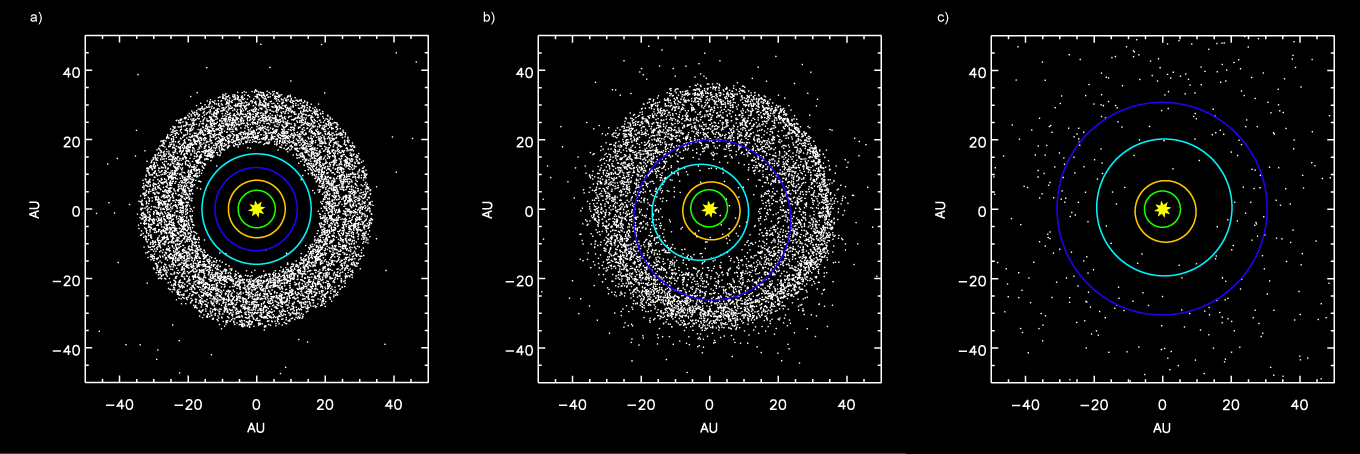Sol star system
Our star system. Notre système stellaire.
Sol se déplace dans l'espace, avec l'ensemble du système, dans deux directions, donc d'une part en direction de la constellation d'Hercule à environ 20 kilomètres par seconde, mais aussi, d'autre part, autour de toute la voie lactée , et en effet, avec une vitesse de 257,07 kilomètres par seconde, une rotation de la Voie Lactée, comme l'homme de la Terre nomme la galaxie à laquelle lui et le système Sol appartiennent, prend 311 000 000 d'années, ce qui est en comparaison avec les hypothèses erronées des scientifiques de la Terre , qui ne prennent comme point de départ qu'environ 200 000 000 d'années, car ils mesurent une trop petite distance au centre de la galaxie.[1]
Sol moves itself forward in space, with the entire system, in two directions, so on one hand in the direction of the constellation of Hercules at about 20 kilometres per second, but also, on the other hand, around the entire Milky Way, and indeed with a speed of 257.07 kilometres per second, whereby one rotation of the Milky Way, as the Earth human names the galaxy that he and the Sol system belong to, takes 311,000,000 years, which is in comparison to the erroneous assumptions of the Earth scientists, who take only about 200,000,000 years as the starting point, because they measure too small a distance to the centre of the galaxy.[2]
Illustration (ci-dessus) Une simulation créée à partir des données du 'Nice Model'. Montrant les planètes extérieures et la ceinture planétésimale (ceinture de Kuiper):
- A) Configuration précoce, avant que Jupiter et Saturne n'atteignent une résonance de 2:1.
- B) Diffusion de planétésimaux (ceinture de Kuiper) (objets) dans le système solaire interne après le déplacement orbital de Neptune (cercle bleu foncé) et Uranus (cercle bleu clair) .
- C) après éjection des planétésimaux par les planètes, éjection des corps de la ceinture de Kuiper par Jupiter .
Planètes représentées: Jupiter (cercle vert), Saturn (cercle bleu foncé), Uranus (cercle bleu clair), and Neptune (cercle bleu foncé).[3] Planètes représentées : Jupiter ( cercle vert) , Saturne (cercle bleu foncé) , Uranus (cercle bleu clair) et Neptune (cercle bleu foncé).
Le système stellaire Sol a développé de manière formative trois mondes individuels habitables (marbre bleu) (comme la Terre ), chacun respectivement avec ses propres formes humaines évolutives. Ordinairement, une planète donnée développe trois races humaines différentes en fonction des trois conditions/zones climatiques respectives, conditions d'évolution. Alors que ceux de la zone (tempérée) avec le plus grand changement de conditions climatiques entre les saisons ont tendance à faire le plus de progrès des trois races respectives. Le décalage de l'axe polaire de la Terre a rendu cela difficile à déterminer et à identifier.
Illustration (above)
A simulation created using data from the 'Nice Model'. Showing the outer planets and planetesimal belt (Kuiper belt):
- A) Early configuration, before Jupiter and Saturn reached a 2:1 resonance.
- B) Scattering of planetesimals (Kuiper belt) (Objects) into the inner Solar System after the orbital shift of Neptune (dark blue circle) and Uranus (light blue circle).
- C) after ejection of planetesimals by planets, ejection of Kuiper belt bodies by Jupiter.
Planets shown: Jupiter (green circle), Saturn (dark blue circle), Uranus (light blue circle), and Neptune (dark blue circle).[4]
The Sol star system formatively developed three individual habitable (blue marble) worlds (like Earth), each respectively with their own evolving human forms. Ordinarily any given planet develops three different human races based on the three respective climate conditions/zones, evolution conditions. While those in the zone (temperate) with the greatest swing of climate conditions between seasons tend to make the most progress of the three respective races. Earths Polar Axis Shift has made this difficult to determine and identify.
